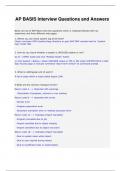Tentamen (uitwerkingen)
AP BASIS Interview Questions and Answers
- Vak
- Instelling
AP BASIS Interview Questions and Answers Below are set of SAP Basis interview questions which is created/collected with my experience and from different web pages. 1. Where you can check system log at OS level? Check /usr/sap/<SID>/system/logs directory or goto SAP MMC console l...
[Meer zien]




